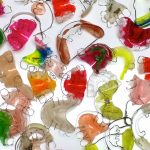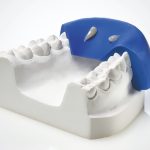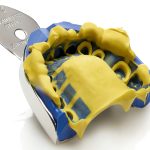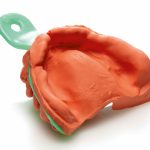Over the past twenty years, a new type of treatment based on the use of “invisible” or clear aligners has gradually earned itself a place in the orthodontic treatment landscape.
This technique involves three fundamental steps:
- the taking of an impression of the patient
- the creation of an orthodontic set-up (a simulation of the final result of the therapy)
- the production of sequential transparent masks
This technique has been constantly improved over the years, as new higher-performance materials, new protocols and new software programmes have made this procedure effective, efficient and safe.
This technique is increasingly popular because:
- it is more cosmetically acceptable; the masks are clear and can also be used in adults who are unlikely to accept a treatment using a conventional metal bracket technique
- it leads to less plaque build-up; the masks are removable and the patient can therefore brush his teeth normally
- there are fewer mishaps during the treatment, as there are no brackets that can become detached or wires that can damage the mucosae
- the chair times are very short
However, in order to be effective, this procedure must be based on a perfect planning and management of the clinical case.
In order for our planning to be perfect, we must necessarily start with perfect impressions of the dental arches and surrounding soft tissues.
The recording of the situation of the arches at baseline is a fundamental pre-requisite; we must obtain impressions that are free of defects, with no stretching, and no air bubbles and the impressions must include all the teeth present in the arch so that the masks fit around all the teeth, including those that are not to be moved. Otherwise, a tooth that is not covered by the mask could erupt to a greater degree than the others and create a pre-contact, which would complicate the outcome of the treatment.
Another fundamental point to bear in mind is the fate of the impressions that are taken; many manufacturers of clear aligners are multinational companies with production sites in different countries around the world.
It is therefore likely that an impression will be subject to intercontinental shipping. In order to survive these long journeys, the material to be used must have one fundamental characteristic, i.e. great dimensional stability over a vast temperature and humidity range.
It therefore goes without say that the impression material is of fundamental importance.
Despite providing good precision, alginate impressions are unable to guarantee prolonged dimensional stability due to their hydrophilic nature, especially in situations of significant changes in temperature and humidity.
Condensation silicones should also be excluded, on account of their short dimensional stability, due to the continuous release of condensation by-products.
Despite being more stable than alginate, polyether is more unstable than an addition silicone (1). Due to its intrinsic hydrophilic nature, polyether tends to absorb or release water depending on the conditions in which it is stored (2) and it is therefore not recommended for this type of impression.
Addition silicones or polyvinyl siloxanes (PVS) are the impression material that currently offers the best dimensional stability, and they are able to resist exposure to different temperature and humidity conditions for long periods of time. Addition silicones also guarantee optimum surface detail reproduction and elasticity.
This makes addition silicone the material of election when taking impressions for clear aligners.
Fundamental proof of this statement is that it is required by the leading clear aligner manufacturers on the market The only material in which impressions can be sent to these large manufacturing sites is addition silicone, and alginates, condensation silicones and polyethers are not accepted.
Now that we have identified the most suitable material, we will take a look at the right impression tray to be chosen.
This type of impression is usually taken using plastic impression trays. These trays have the great advantage of being less expensive than metal ones. This is an advantage because, as mentioned previously, the impressions are sent long distances and there is little hope that they will be returned.
Leading clear aligner manufacturers provide their own plastic impression trays, in order to avoid the variables and management difficulties that would arise if each dentist were to choose his own impression tray.
It goes without say that if the clear aligner is to be produced by a dental laboratory close to the practice, it is possible to use conventional metal impression trays, duly pre-treated using an adhesive for addition silicones.
Now that we have identified the impression tray, we will take a look at the impression technique.
This type of impression does not involve areas, as is the case with prosthetic impressions, where we need to obtain the greatest possible precision, for example, when preparing a crown. In short, it is necessary to obtain an impression that is free of errors, air bubbles, voids, stretches or artefacts. The ideal impression for invisible orthodontics must include all the teeth, including those that are worst positioned, to include at least the gingival margin (the height at which aligners are usually made to finish).
As it is a precision impression, two techniques may be used:
- simultaneous impression
- two-step impression
Two-step impressions consist in a first impression taken using a high-density material, from which the undercuts are subsequently removed. After this step, the low-density material is loaded into the modified first impression and the second impression is taken.
Another very common technique involves the use of a cellophane sheet to be applied on the high-density material before positioning the impression tray during the first impression. The advantage is that, when the cellophane sheet is removed, it is not necessary to remove the undercuts, making it possible to proceed directly with the second impression using the low-density material.
The main disadvantage of this technique is that it nevertheless involves two impression times; however, it affords the advantage of good precision, as using the first impression as a custom impression tray reduces the risk of errors, especially in the presence of severely misaligned teeth.
Simultaneous impressions can be either mono-phase or two-phase. Mono-phase simultaneous impressions consist in a single impression phase using just one material, usually with an intermediate density. Two-phase simultaneous impressions, on the other hand, consist in a single impression phase using a high-density material positioned as a base on the impression tray and a low-density colour-contrast material, which will be the first to come into contact with the occlusal part of the teeth during impression-taking.
The advantage of a mono-phase technique is undoubtedly the shorter time required; however, in situations with severe misalignment a second impression may be required. Use of a two-phase simultaneous technique is to be recommended as it affords better impression reading than a mono-phase simultaneous technique.
Leading clear aligner manufacturers recommend using a two-phase simultaneous technique and dispensing materials using automatic or semi-automatic systems rather than mixing by hand.
The last step consists in checking the impression. This step is essential, especially when using clear aligners that are produced a great distance from the dental practice. If the dentist overlooks an error in the impression and it is sent, he will not find out that there was an imprecision in the impression calling for a new impression to be taken until a long time later, when the model is cast. These delays are likely to lengthen treatment times and can be a source of stress for both the dentist and the patient.
References
1) Gonçalves, F. S., Popoff, D. A. V., Castro, C. D. L., Silva, G. C., Magalhães, C. S., & Moreira, A. N. (2011). Dimensional stability of elastomeric impression materials: a critical review of the literature. European Journal of Prosthodontics and Restorative Dentistry, 19(4), 163.
2) Kanehira M, Finger WJ, Endo T. Volatilization of components from and water absorption of polyether impressions. J Dent 2006;34(2):134-8.
Do you want more information on Zhermack Dental products and solutions?
Contact us




 Zhermack SpA has been one of the most important producers and international distributors of alginates, gypsums and silicone compounds for the dental sector for over 40 years. It has also developed solutions for the industrial and wellbeing sectors.
Zhermack SpA - Via Bovazecchino, 100 - 45021 Badia Polesine (RO), Italy.
Zhermack SpA has been one of the most important producers and international distributors of alginates, gypsums and silicone compounds for the dental sector for over 40 years. It has also developed solutions for the industrial and wellbeing sectors.
Zhermack SpA - Via Bovazecchino, 100 - 45021 Badia Polesine (RO), Italy.


